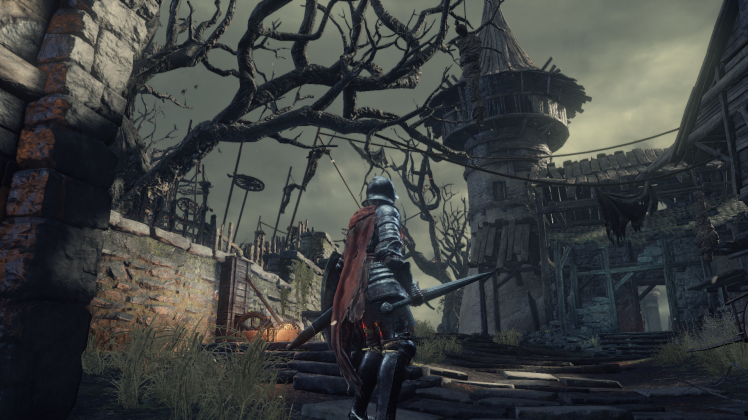A criticism that I often hear about certain games, is that they are trying to be movies. And I completely agree, granted movies are wonderful (well a lot of them are, there’s plenty that suck too) but video games are most definitely not movies.
Now you may be thinking that there is nothing wrong with games trying to be movies, they are both visual mediums, with movement and camera angles and stuff that means they can tell stories in a very similar way if they wish. But the problem is, no matter how hard a game tries, to have a truly movie like experience they have to do one very important and rather egregious thing, they have to take away control.
Often games will end up being sets of shooting galleries, book ended by big long cutscenes where you don’t have any effect or agency in what is going on. The part of the game that is actually a game seemingly just a conduit to move you to the next part of the movie.
This sort of narrative within a game isn’t the worst thing ever of course, if the games story is good and the gameplay is fun it is fine, I get a nice movie and I also get a fun play session, fine. But there is so much more this medium can do. There is a plethora of unique ways of telling stories that are practically impossible in books or films that should be embraced, and really stretched and experimented with to help the young medium of video games really find its feet.
First off, let’s talk about a form of storytelling in video games I’ll call the “exploratory approach”. This type of storytelling is something you can see done expertly in From Software games, such as Dark Souls and Bloodborne.
You see, Dark Souls has no real central narrative thread, there is no “plot” as one could put it, at least not a traditional plot. But the game also isn’t just a big gameplay experiment with no story at all, like Minecraft, or the thousand other completely open sandbox games that exist nowadays.
Dark Souls core is strong gameplay, and a tough but fair difficulty that pulls one in just for the sheer craft of it all, the world is superbly designed to be a dark, western style fantasy too, which gives ample opportunity for interesting level design and enemy encounters. But just on the edge of vision, in item descriptions, spelled out in cryptic comments by NPCs and in the design and placement of different enemies, is a story.

Nothing quite says dark fantasy better than multiple strung up corpses and architecture that is a health and safety nightmare.
This sort of storytelling is quiet, away to the side, you can engage with it as much or as little as you want. One can play through all of Dark Souls and never even spare a thought to the world or characters they hear about through hearsay or descriptions, or contemplate why certain bosses are where they find them, or why they are the twisted creatures or people they fight.
Being able to engage with the game without ever having to engage with the story is interesting, and is more or less impossible to do with films or books, since in those two mediums you need some central goings on to be watched or read about, which need to retain interest, so usually have to be a story of some kind. But games can simply stand on a base of technical and mechanical enjoyment, but still have the story open to be inferred about and engaged with in an entirely different way than you do with a main plotline.
A great example of this is a recent experience I had in Bloodborne when watching a friend play. Of course we had the fun of them trying their best to overcome the dangers that the world presents on the more technical side, lots of dying to and name calling at the hulking monstrosities they fought. But we also started to wonder about a specific type of stat that you get. Something called insight. At first we just thought it was another thing that one acquired that lets the player unlock certain aspects of the game as they progress, which granted it is, opening up shops and certain characters that weren’t there before.
But at one point we realised that the item you get to increase said insight, is called madman’s knowledge. And that put us onto an idea, you see in Bloodborne you are something called a hunter, and your main job is fighting monsters in this dark Victorian esq town. You do see other people but they are all locked up inside their houses, some of which sound like they are celebrating for some reason. And given that their town appears to be infested by monsters it seems a tad odd that they would be throwing a party, at least it’s not something I would do, I would be more of the shitting myself and taking multiple trips to the lock store type person.
So given that this insight stat makes more monsters appear, and you get more insight via an item called madman’s knowledge, we started thinking that maybe all these monsters the player has to fight aren’t even visible to the regular folk, maybe to them you’re just some crazy person running around the town at night and swinging your sword at nothing… which makes a lot of sense since none of them are willing to open the door when you knock. I probably wouldn’t let a heavily armed crazy person into my house either.

To be fair on the hunters, holding on to one’s sanity while fighting this sort of big baby faced bedsheet wearing monster is probably a little challenging.
This was quite the intriguing idea and seemed to line up with a lot of the subtler points of the game we have seen so far, and all that was merely our own thinking on the topic. The game never specifically says that, nor does it need to. For the player to enjoy the game for its ascetic and combat they don’t need to know any of that. It’s all just finer interesting story points that exist for the player to find, but aren’t necessary for the player to know to just enjoy the game as a game.
Secondly, there is the far more used type of game storytelling, interactive storytelling. Used most popularly in games like Mass Effect, Dragon Age, Telltale’s Walking Dead series and also Undertale.
Now this is quite interesting, because the idea of interactive storytelling comes in a lot more forms (and also has a lot more examples that I can think of). I will look at two categories for now, but there could be far more than just what I’m looking at here. The first is the sort of, “interactive film style narrative” that isn’t completely video game exclusive, given things like choose your own adventure books, but games can still do them very well. The other is the, “what you do is the story” kind of game.
Let me clarify here, the Walking Dead is a prime example of the “interactive film style narrative”. You go through the game and make decisions about what the main character will do in certain situations.
This has two main effects. It really feels like you impact the story as you are guiding it the way you see fit, you decide, at least partially, the course of the narrative, making you a lot more invested in it in the process. Also the effect that due to the main characters decisions being your own, you end up almost immediately having a strong connection to them. It takes a lot to make you relate to a character in books and films, but in a game like this it can really cut out a whole lot of steps as you very quickly feel like they are you, they are your conduit into this world (of course this happens if you just control a character in a regular game, but the fact that you make their decisions in the story too really cements this idea).
This type of storytelling also helps a lot with in game romance, which I can attest to given that Tali’Zorah is my space wife who I love very much.

And that affection has absolutely nothing to do with the skin tight outfit I assure you… well it at least has very little to do with it.
But then there is the “what you do is the story kind of game”. Now a fantastic example of this is The Stanley Parable. The whole story of that game, is about the idea of story and freedom in games. The idea of “is anything you do free in a game if the path is already laid out”. And the only way to interact with that story is via play, you interact with the narrator not in ready cutscenes where you choose what your character will say, but by how you move, by what buttons you press at what time, how long you linger in a certain area. The story itself is how you interact with the game via its play.

As you can probably tell from this picture, it is a truly high octane game. Non-stop action, is clearly Stanley’s middle name.
The crowning moment of this in The Stanley Parable is probably right at the beginning. It is a great hook and really shows you exactly what the game is offering. You see, playing as Stanley, you leave your office looking for your co-workers and come to two doors. The narrator says “Stanley took the door on the left.”
You see this is fantastic due to the fact that, there are two doors, you at this point know what you are capable of as the player, you can walk and open doors, and you have been given a very strict instruction, the narrator has said you have already done something, it’s in the past tense. But you can walk over to the door on the right, open it up, and walk on through.
The narrator stumbles at what you have done, since you have gone completely against what he has said, and proceeds to give you multiple ways to get back onto the course that he first set, but you can continuously flout him simply by either doing the opposite, or to begin to do as he says but then start exploring other parts of the office that he has not mentioned.
This can lead to him to either hastily trying to narrate around what you are doing, trying to get you back on the path, or in some cases joining your rejection of the laid out story and having a bit of fun with the new path that you are taking. There is even a whole arm of the story that you can take if you decide to walk into a broom closet and stay there for extended periods of time (which by the way is great, the broom closet ending is truly fantastic).
This story entirely depends on it being an interactive medium as almost every minute movement, or even looking at something for too long, can spark new developments in the narrative.
Needless to say while the first sort of interactive story is somewhat copiable in choose your own adventure style books, the latter type of interactive story is so unique to gaming and is such a treat to see done well. A story that can only truly be experience through a game is a beautiful thing to see, and gives me a lot of hope for the future of such a young medium.
Thank you my truly delectable reader for wading through all my incessant rambling. I hope you have enjoyed it, or at least bared it and tried to pretend it was okay, like when English people have to talk about rain and call it good British weather.
Last but not least I will leave you with this lovely picture from Mass Effect 2, of the Illusive Man’s rather awesome yet kind of impractically large windows in his space station.

All images sourced through creative commons from Videogame Photography, Rob Obsidian, Ryan Somma and Wikimedia commons.

This was a pretty great read. I do really enjoy it when games like Dark Souls can get you to engage with the world without you even have to follow its story. I feel like Metroid Prime on the gamecube was quite similar. Unless you went out of your way to scan various logs and read them, you’d have very little motivation to move onto the next area other than to survive.
LikeLiked by 1 person
I’m glad you enjoyed the article. Yeah I find storytelling in videogames where the actual narrative is kind of a mystery in itself so fascinating. I may have to go back to Metroid Prime at some point as I think I played it when I was quite young so never actually got into it and don’t really remember much.
LikeLike